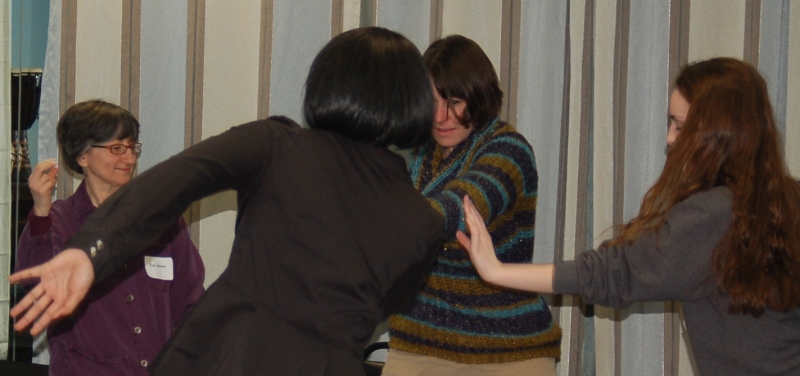Dance/Movement Therapy Q and A

September 3rd, 2014
By ITA Dance/Movement Therapist Deanna Roberts
Q: What is Dance/movement therapy (DMT)?
A: The American Dance Therapy Association defines DMT as the following:
“Dance/movement therapy is the psychotherapeutic use of movement to further the emotional, cognitive, physical and social integration of the individual.” This definition is based on “the empirically supported premise that the body, mind, and spirit are interconnected.” (2014, http://www.adta.org)
Q: That’s a lengthy answer for a simple question. What’s it mean? What’s the purpose of using DMT in therapy?
A: Dance/movement therapy recognizes that our bodies and movements are connected to the way we feel, think, act, and communicate to others. While some regular forms of therapy might focus solely on changes in thoughts or behaviors to support emotional and mental health, DMT looks at how certain body postures, gestures, and full-bodied movements are connected to specific emotions and thoughts.
Q: So, I’m imagining that means you have to be able to dance or something, right?
A: Although DMT does incorporate “dance” because it’s a creative and expressive therapeutic form, it involves much more than simply dancing for emotional expression. Instead, DMT looks at the relationship between movement in general, such as healthy developmental patterns of moving, preferences for certain movement qualities, and spatial and bodily awareness, for personal and social health.
Q: Where is DMT used?
A: DMT is practiced in a wide variety of settings, including hospitals, rehab centers, nursing homes, preventative health programs, schools, childcare facilities, and private practices. ITA is now offering individual therapy, using DMT, for both children and adults.
Q: What types of populations use DMT?
A: DMT can be used to offer support to a number of individuals, including children working on normal, psychosocial development, addressing goals to increase self-awareness and understanding, appropriate emotional expression, and recognizing healthy, safe ways for social development. DMT has also been effective in treating children with Neurodevelopment Disorders, such as Autism and ADHD. Here, goals might include altering and changing patterns of movement to treat restricted behaviors and explore more flexible responses to the environment or find ways to better self-regulate and increase attention/listening skills.
Q: That sounds like it’s mostly for children, what about adults?
A: DMT is also a highly effective way to treat adults and has been used with those who have anxiety, depression, or other mood disorders, as well as individuals affected by physical or physiological impairments. Some of the goals here might include understanding how worried, racing thoughts affect tension and patterns of movement in the body or how feelings such as sadness, low-motivation, or lack of energy/fatigue can be influenced by changes in body posture or practicing recuperative body-mind techniques.
Q: How do I know if my child or I might benefit from DMT?
A: If you are looking for mental health or therapeutic support in any capacity for you or your child, DMT might be a great alternative to traditional therapies. Instead of merely looking at customary cognitive, behavioral, or emotional interventions, DMT takes a holistic approach, recognizing that often the way we think, act, or feel is inherently connected to the way we move, hold ourselves, and interact with the environment and those around us. Many individuals do not realize how connected an emotional or mental health problem and bodily movement patterns may be. DMT might be best thought of as another form of counseling/therapy, but with a body-mind, movement-oriented approach.

Q: Wait..so it is like counseling?
A: Yes! Dance/movement therapists are dually trained as counselors with familiarity and experience using traditional counseling/therapy techniques. This includes a variety of other individual and group therapy approaches.
Q: How do I find out more about how DMT is used?
A: Below are some links to some great informational brochures about the use of DMT with some specific populations, but this list is by no means exclusive.
DMT & Children
http://www.adta.org/resources/Documents/Info-Sheet-DMT-Children-with-Resource-Bibliography.pdf
DMT & Older Adults
http://www.adta.org/resources/Documents/Info-Sheet-DMT-Elderly-with-Resource-Bib.pdf
DMT & Autism
http://www.adta.org/resources/Documents/DMT-with-Autism-Informational-Sheet.pdf
DMT & Eating Disorders
http://www.adta.org/resources/Documents/infosheetDMT-EatingDisorders.pdf
Q: If I’m interested in hearing more about DMT for me or my child or scheduling an intake interview who should I call?
A: ITA currently has a dance/movement therapist and licensed counselor on staff who is available for individual sessions with children or adults. The intake process is easy and starts with a phone call to Marni Rosen, Practice Manager at ITA. Her contact information is below. You can express your interest in exploring DMT as an option for services when you call.
Marni Rosen, Psy.D ATR
Practice Manager
Licensed Clinical Psychologist & Art Therapist
Direct phone: (847) 448-8336
Intake Line: (847) 425-9708 ext. 590
Deanna Roberts, LPC, BC-DMT, GL-CMA
Dance/Movement Therapist and Counselor
Phone: (847)425-9708, Ext. 538
Deanna is a dance/movement therapist and licensed counselor with experience working with adults and children in clinical and preventative health settings. She is currently available to schedule new clients and her services can be covered with some clients using BCBS PPO or submitting independently for partial reimbursement through their insurance company. Please inquire about your individual health insurance plan for more specific information.
